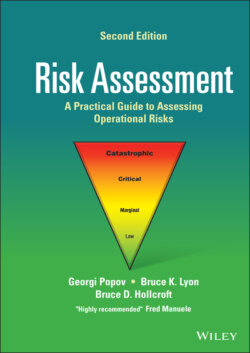Читать книгу Risk Assessment - Georgi Popov - Страница 69
3.15 Monitoring and Continuous Improvement
ОглавлениеThey say that only one thing is certain, and that is there will always be change. With that in mind, it is important to monitor risk assessments and the hazards and operations they cover. Hazards and operations continuously change and with these changes come new and different risks. Examples of these might include different equipment, processes, operating environments, production rates, etc. Each of these changes could have an effect on the existing controls and their effectiveness. Thus, it may be appropriate to update risk assessments to consider these possible changes.
New technologies and controls are also being created and monitoring these may offer opportunities to improve controls and further reduce the risk. New controls that are being introduced may be higher in the Hierarchy of Controls and more reliable. An example might be the Global Positioning Systems (GPS)/telematics available for vehicles today. In the past, driver training, instruction, and possibly their logs were manually used to monitor their location, speed, and driving performance – controls consider low on the Hierarchy of Controls. The GPS/telematics of today are much more accurate, factual, and reliable and might be considered higher on the scale.
Monitoring, updating, and further reducing of risk is continuous improvement. In fact, risk assessment done properly is the perfect example of a continuous improvement process. Certain risks that are accepted today will not likely be accepted in the future. There are a variety of reasons for this condition. Personal expectations are always increasing. People increasingly expect working environments that are more comfortable, convenient, and safe. This expectation comes with the improvement in technology and working conditions, as well as enhanced knowledge of risks. This is especially true as more people work for someone else as opposed to being self‐employed and willing to take more risk. Not too long ago many people would have been satisfied just working indoors at a desk. Now the expectation is that the room is properly air conditioned, and more and more people are expecting good ergonomics like sit/stand workstations. Expectations will continue to rise as will technology resulting in continuous improvement.
Regulations and standards also continue to have higher requirements to keep up with technology and expectations. The methods of improving the safety of hazards and operations and reducing the resulting risk are getting dramatically better. Thus, regulations and standards are being amended and developed to require these improvements. This is continuous improvement and risk assessment can lead the way. The term ALARP or as low as reasonably practicable is used in this book and what is reasonably practicable is increasing continuously enabling risk to be further reduced going forward. Think about fire, smoke, and carbon dioxide (CO2) detectors. At one time, they had not been invented. Then, they were invented but expensive and only used for major hazards and operations. Now, they are simple, inexpensive, and installed in most homes.
